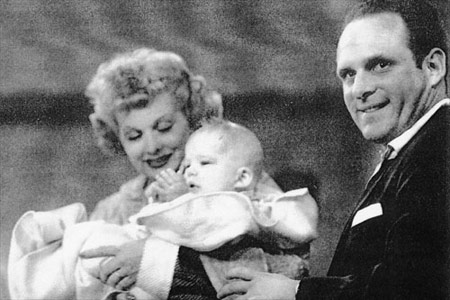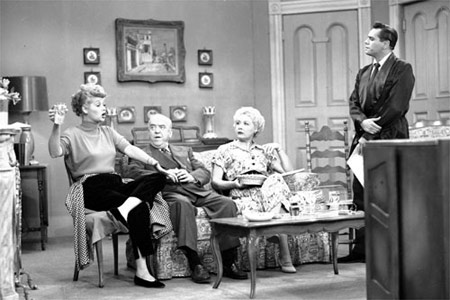Scripts, Rehearsals and Showtime Folks
Live Audience and Directing
In his book, And the Show Goes On, television pioneer Sheldon Leonard wrote about another of Arnaz' decisions: "Operating on the well-founded belief that a comedy show needs an audience to give it the authentic response that canned laughter can never duplicate, Desi brought in an audience to watch and react, while he used multiple-camera shooting technique borrowed from live TV."
Arnaz also "borrowed from live TV" director Marc Daniels who would sit in the director's chair for the filmed I Love Lucy. Daniels' contribution to choreographing three-camera technique was considerable and influenced generations of television directors.

James Nicholson, William Asher and William Quine on the backlot at Columbia Pictures.
Daniels would direct all of the first season's 35 episodes, a season uninterrupted by today's all-too-common reruns. In the DGA Oral History, The Days of Live edited by Ira Skutch, Daniels said, "I'd had the multiple-camera experience. [Lucy] was similar to live, except that the film cameras were much less flexible than the television cameras. You were stuck with the side cameras being the long lenses for close-ups and the center camera being the master camera, and you couldn't change a lens as quickly.
"We began I Love Lucy using four cameras because they wanted to do the entire first half of the show without stopping," Daniels continued. "We had four Fearless dollies, four dolly grips, four camera assistants, two booms, two dolly grips for the booms, and a few cable men. You can imagine what that floor looked like."
After the first season, Daniels moved on to direct other shows. William Asher, who would later produce 285 episodes, and direct 200 episodes himself of another television classic, Bewitched, came on board, becoming the directing mainstay for many years, and further refined and perfected multi-camera technique.
Trouble on Day One
Asher's first day on the set though nearly ended his association with the show. They had begun rehearsal and Asher had to walk away for a bit to attend to some technical matters. When he returned, he discovered that Lucille Ball had been giving directions backstage. Asher was astonished.
"I said, 'Lucy, there's only one director. I'm it. If you would like to direct, then don't pay me and send me home,' " Asher said. "When I said that, she began to cry and ran off the stage. Everybody disappeared. Desi hadn't been in the scene. I didn't know where to go because I had no office. So, I went to the men's bathroom, sat on the toilet and didn't know what the hell to do. I realized I'd blown my first day of what was really a pretty good job.
"I sat there for a long time and finally got up and went back to the stage," he continued. "Desi was there. He was furious. He was cussing me out in Spanish and I didn't know what he was saying. I settled him down and said, 'Look, Desi, here's what happened.' And he said, 'Well, you're absolutely right, Bill. What you should do is go in to Lucy's dressing room. She's crying. Go talk to her and settle this thing.' So that's what I did. I went in. I said I was sorry I upset her. And she was crying and I started to cry. And after a while we went back to work. But I'll tell you this. I never had trouble from her after that. She had her opinion, and would offer it, but nothing ever behind my back. Everything was just fine. That's the way it was for the next five years."

On the set of I Love Lucy with Lucille Ball and William Asher
Scripts, Rehearsals and Showtime Folks
Asher said they began working on each season of Lucy with between six and seven scripts that were in very good shape. "The scripts were excellent," Asher recalled. "We had only the producer [and head writer], Jess Oppenheimer, and two other writers who wrote as a team [Madelyn Pugh and Bob Carroll, Jr.]. And that's all we had. Today you see 9, 10, or more writers." Oppenheimer, Pugh and Carroll had also been the writing team of Ball's hit radio comedy My Favorite Husband. In Lucy's later years Bob Schiller and Bob Weiskopf would write episodes.
Asher said there was very little ad libbing because the material was strong and they'd had time to rehearse. "On Monday morning we would read the material, discuss it and make changes. In the afternoon, I would start rehearsing and continue rehearsing Tuesday and Wednesday when the cameras came in. On Thursday, we'd rehearse again with cameras about half the day. Then we would do a dress rehearsal. Later that day, we'd do the show."
Rehearsals were vital because they were shooting film. At the time there were no monitors for the director to see the image. The show's quality depended on his ability to watch the floor and ensure that all cameras and actors hit their marks at the required moments. Precision was crucial, as nobody wanted to halt the performance in front of an audience. They rarely shot pick-ups, Asher said, and when they did it was usually for a guest star who forgot a line. Most shows were filmed in around thirty minutes.
"We had stops for Lucy's big costume changes, but that was all," Asher said. "I had a pretty strict rule on that. We didn't stop for anything. We played it like a Broadway show. If an actor made a mistake or forgot a line or something like that, it was up to the other actor to get him out of it."

(Top) Lucille Ball performs the famous "Vitameatvegamin" scene (Below) Lucille Ball, William Frawley, Vivian Vance and Desi Arnaz in a scene from I Love Lucy

Asher can recall only one time when the show came to a dead stop. "Lucy always had one moment where she'd get stuck. We'd put that line of dialogue on the back of a lamp or something where we knew she'd be working. Once, right in the middle of a scene she suddenly stopped. And she was the only one in the scene, alone in the living room. I waited and waited. She just was staring at something. Finally, I yelled 'cut' and ran down to the set and saw she was staring at the back of a lamp where we'd put her line. She said the line didn't seem right to her. It turned out that the lamp we were using in that show broke after dress rehearsal, and the crew brought in another lamp that had a line from a previous show from the year before on it. We explained it to the audience and replaced it with the right line and went on. It was the only time we stopped."
Yet Another Innovation
On Friday, Asher would cut the show with the editor, and on Monday, during lunch following the next show's read through, he'd watch the prior week's show with Arnaz who would give his comments.
The editing of I Love Lucy brought another major innovation to television. Arnaz said that when he first sat down to watch the film, he found it very confusing to look at only one camera's footage on a Moviola. He asked why he couldn't see the film from all three cameras at the same time. He was told that this was the only way — one camera's film at a time. Arnaz pushed the issue and asked, "Why can't you just stick three Moviolas together?" So the production team contacted Moviola's president, Mark Serrurier, son of Iwan Serrurier who had created Moviola in 1924. A graduate of Caltech who oversaw the design of the dome and structural parts of the 200-inch Palomar Telescope, Serrurier developed a three-headed machine to speed up the editing process on Lucy.
Jay Sandrich, who would establish his own directing legacy on The Mary Tyler Moore Show, Soap and The Cosby Show, began his career as a 2nd AD on I Love Lucy. He moved up to 1st AD when Jack Aldworth moved up to producer. "I was 24 and I knew nothing," Sandrich said. "I was learning on the number one show in the country. Aldworth was a wonderful mentor who really helped me."
After thousands of reruns in syndication, it's sometimes easy to forget just how innovative I Love Lucy was to the history of sitcoms. But it set the stage for further technical innovations, for influential independent producers like Sheldon Leonard, Norman Lear, and Grant Tinker, and for strong directors whose voice and commitment to the idea that "There can be only one director" would continue to perfect the uniquely American art form known as the sitcom.